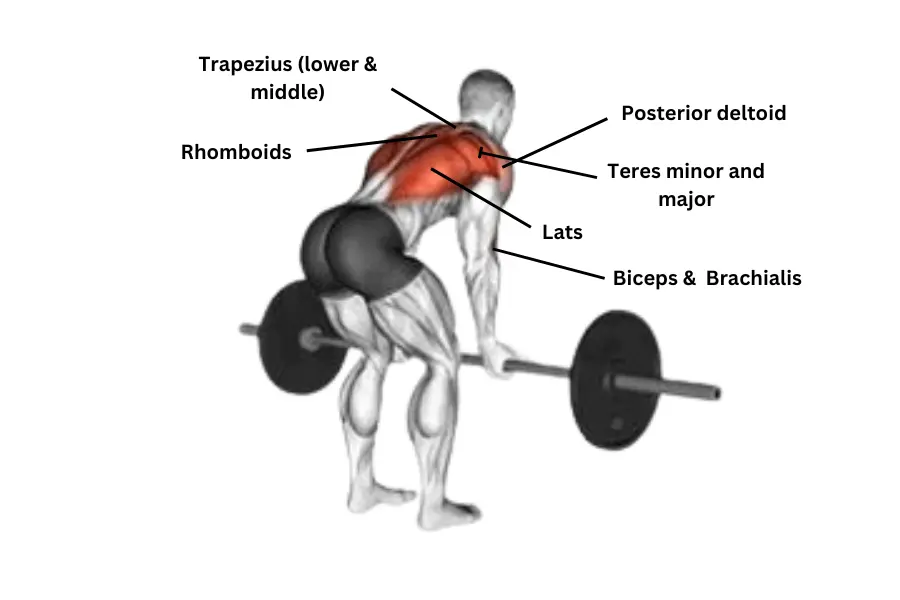When it comes to biceps training, bent-over rows are often considered an ideal exercise, but using a supinated grip can better engage your biceps.
While a pronated grip is fine for back development, a supinated grip allows you to pull the bar in a way that activates your biceps more effectively.
Apart from everything, keep in mind that executing this exercise properly requires strength and proper form, so don’t forget to wear your weightlifting belt for added support and stability.
Bent Over Barbell Row Muscles Worked
The bent-over barbell row is an effective exercise for building and strengthening your upper body, targeting various muscle groups from your back to your arms.
The primary muscles worked during this exercise include the latissimus dorsi (lats) and biceps brachii.
As the name suggests, using a supinated grip allows you to specifically target your biceps.
It’s impressive how a slight adjustment in your grip during this exercise can influence the shape of your biceps.
While you can perform this exercise with a pronated grip, it won’t activate your biceps as effectively as a supinated grip does.

Additionally, secondary muscle groups activated throughout the movement include the rhomboids, trapezius, posterior deltoids, brachialis, and teres major.
We recommend doing this exercise in the mid-section of your workout routine.
By doing so, you can maintain most of the tension in your biceps from previous exercises, facilitating better growth and development.
Benefits of the Bent Over Barbell Row
Bent-over rows are often considered a top exercise for biceps, and here are 3 key reasons why they should be included in your upper body workout routine:
Build Back Strength
Barbell rows engage a broad spectrum of back muscles, including upper and lower back muscles, promoting stability and flexibility throughout your back.
Strengthening these muscles not only enhances your performance in other bodybuilding exercises but also reduces the risk of back injuries, effectively bracing your back like a solid foundation.
Bigger Lats
Every lifter wants to build an ideal physique to look stronger and have an aesthetic body.
Developing well-defined lats is a cornerstone of this objective.
Lats are the largest muscle group in your back, connecting to your armpits, and growing them is key to looking big.
Barbell rows mainly focus on lats, making it simple to target them without needing extra back exercises in your workout routine.
How to Do Bent Over Barbell Row
Equipment: Standard Barbell
Grip: Shoulder width Apart (palms facing up)
Primary Muscle Work: Latissimus dorsi (lats)
How to Do
- Grasp a barbell with shoulder width apart, palms facing up (underhand grip).
- Keep your legs straight, and your chest puffs out. Bent your knees slightly and lower your upper body as far down as possible.
- Start by pulling your elbows backward towards your torso while retracting your shoulder blades.
- Lower the barbell to the starting position, extending your arm at the bottom.
Bent Over Barbell Row Tips
- Focus on the Eccentric: Control the descent of the barbell to maximize muscle activation during the eccentric (lowering) phase of the exercise.
- Keep Elbows Close: Maintain a tight grip on the barbell and keep your elbows near your body to effectively work your back muscles.
- Position Your Feet Right: Stand with your feet hip-width apart and slightly bend your knees for stability and equilibrium throughout the workout.
Common Mistakes
With proper form, barbell rows can be done without any mistakes, but there is always room for mistakes. Here are some common pitfalls to avoid to maximize your results:
Over-upright Stance
Overlooking your stance can sap away all the tension from your focus muscle, which will make the exercise harder and more uncomfortable to execute.
Your body should be at a 90-degree angle or slightly beyond a 90-degree angle to perform this exercise in proper form. This helps you maintain a proper stance without going excessively upright, allowing your muscles to receive the necessary tension without risking injury.
Rounding Your Back
Numerous new lifters often lift the barbell without noticing their spine posture being curved outwards, or they know but ignore it as it helps them lift the bar with less effort.
While this may seem advantageous initially, it can lead to discomfort and pain in the back over time.
Your lower and upper backs should remain in a neutral and flat position throughout the movement.
Alternatives and Variation
- Dumbbell Bent Over Row
- Seated Cable Row
- Inverted Row
Dumbbell Bent Over Row
Apart from a barbell, dumbbells stand out when it comes to variations in exercise.
Using dumbbells for rows helps you independently move your arms and deeply stretch and contract your back muscles at the top and bottom of the movement.
This activates your latissimus dorsi (lats) along with the engagement of shoulder blades, upper back and neck muscles, and biceps.
Seated Cable Row
The seated cable row is an upper-body focus alternative that works your lats, traps, rhomboids, rear delts, core, and biceps.
This exercise is executed while seated on a cable machine and pulling the cable with your hands toward your body.
It is great for building upper body strength and a strong, flexible back, which can be beneficial for lifting heavy weights.
Inverted Row
An excellent alternative to the barbell row is the inverted row, which requires pulling yourself with your body weight towards the bar.
Inverted rows can target the latissimus dorsi, trapezius, rhomboids, infraspinatus, teres minor, erector spinae, posterior deltoids, biceps, and forearms.
While the bicep is not the primary target, it can engage your biceps to a greater extent if done properly.
This exercise might be difficult for beginner lifters, as it takes practice and experience to do.
However, with determination and some guidance, even beginners can conquer this exercise and reap its benefits.
Featured Image Credit Marcus Filly/YouTube